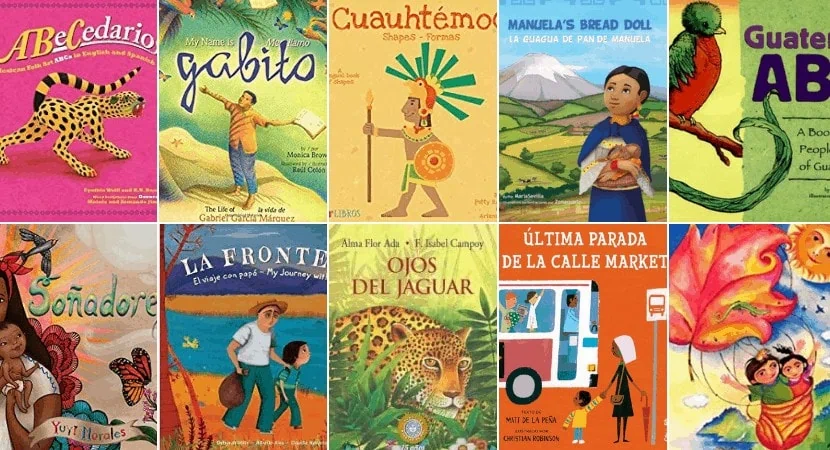Sample Spanish Scope and Sequences for Different Levels
Inside: See how different programs and teacher set up their Spanish scope and sequence, to help you create yours.
If you are using a traditional textbook, you most likely have your scope and sequence pretty well laid out for you.
If you’re like me, you’re using a mix and match of curricula and need to come up with your own!
Once you get a detailed scope and sequence together, it really does help as you come up with lesson plans and daily activities. I find I mainly get bogged down in formulating things like essential questions, objectives, and “I can” statements. Instead of starting from scratch, draw from these examples below!
Content:
1. Spanish 1-4 Scope and Sequences
2. Elementary Spanish Scope and Sequences
3. Preschool Spanish Scope and Sequences
Below I’ve collected my favorite examples, so you can browse around and get ideas. My favorite scope and sequences are centered on high-frequency and high-interest themes.
Spanish 1 Scope and Sequences
Alice Ayel has scope and sequences set up for several levels, including Spanish 1. In this link you can see what she created for grades 6 – 12. The PDFs include topics, guiding questions, objectives, and cultural components and assessments. They are ordered by fairly traditional vocabulary themes.
Carrie Toth has also shared her scope and sequence for Spanish 1-4, in a succinct, at-a-glance format. She uses Somos, novels, and Huellas and lists the goals for each unit.
Musicuentos has Spanish 1 here, with the categories vocabulary, grammar, and culture for each unit.
The EntreCulturas scope and sequence is really helpful for seeing examples of essential questions and unit objectives.
These syllabi for Spanish 2-4 from Williamson and CI are nicely laid out as well. You can get an idea of how to base your units around cultural themes and see how a teacher introduces the preterite, imperfect, conditional and subjunctive in a CI context.
Here is another example that has aligned ACTFL standard and essential targets by units. (You can see where they place standards like interpersonal communication, interpretive communication, presentational communication, relating cultural practices and perspectives, making language comparisons and connections, lifelong learning, and acquiring information and diverse perspectives.)
Elementary Spanish Scope and Sequences
Calico Spanish has a really nice elementary Spanish curriculum outline, complete with themes and “I can” statements.
Here is another example from Sonrisas 1.
This sample from Livingston Public Schools shows a simple outline of main topics and vocabulary for their K-5 Spanish classes.
Here is a Middle School example as well. It’s just a list of sequential lesson objectives, but I wanted to include a middle school example!
Preschool Spanish Scope and Sequence
I have developed my own Preschool and Early Elementary Units, so I can share those directly here. Even if you don’t use my units, sometimes it’s helpful to see wording and examples for these ages!
(These units are based on providing lots of comprehensible input instead of isolated vocabulary lists.)
| Los Pollitos Unit 1 | Los Pollitos Unit 2 |
Learners will be introduced to farm animals and learn some basic greetings. | Learners will learn to express likes and dislikes. They will identify colors and some foods. |
| High-Frequency verbs: dice(n) Core vocabulary: buenos días, ¿Cómo te llamas?, Me llamo los pollitos, el caballo, el pato, el perro, el gato, la vaca, el cerdo, la oveja | High-Frequency verbs: te gusta, me gusta, no me gusta Core vocabulary: tiene hambre, come, toma, la manzana, la leche, el maíz, el pan, el agua, el queso, la zanahoria, las uvas, los arándanos, la galleta, el helado rojo, anaranjado, amarillo, verde, azul, morado, blanco, negro, rosado, café, gris, pinta |
| I can understand a story with familiar words. I can greet others. I can say my name. I can recognize some animal names. I can say some animal names. | I can understand a story with familiar words. I can recognize and name some foods. I can say that I like or don’t like something. I can name and recognize some colors. |
| Los Pollitos Unit 3 | Los Pollitos Unit 4 |
In this unit, learners will start describing objects, animals, and how they feel. They will be introduced to the days of the week. | In this unit, learners will learn a traditional Spanish song for children. They will learn to count to ten. |
High-Frequency verbs: eres, soy, ve Core vocabulary: hace frío, hace calor, triste, feliz, grande, pequeño, busca, amigos, busca, mi, tu, mamá, lombriz, la rana lunes, martes, miércoles, jueves, viernes, sábado, domingo Review: colors, adjectives, greetings, animals, actions | High-Frequency verbs: les da, le da Core vocabulary: la comida, duerme, se despierta uno, dos, tres, cuatro, cinco, seis, siete, ocho, nueve, diez Review: colors, numbers, adjectives, greetings, animals, actions |
I can understand a story with familiar words. I can describe some people and things. I can recite the days of the week. I can ask and answer very simple questions | I can understand a story with familiar words. I can talk about bedtime and waking up. I can count 1-10 I can understand an authentic children’s song in Spanish. |
| A Mi Burro Unit 1 | A Mi Burro Unit 2 |
| In this unit, learners will learn about parts of the body and the five senses. | In this unit, learners will learn a traditional Spanish song for children. They will learn about clothing and getting dressed for the day. |
| High-Frequency verbs: ve, va a Core vocabulary: la cabeza, la boca, los ojos, las orejas, la nariz, el pelo/cabello, huele, escucha, come, habla los brazos, las piernas, las rodillas, las manos, los pies, el corazón, toca me duele, le duele, la garganta, el médico, se cae Review: colors, numbers, adjectives, greetings, animals, actions | High-Frequency verbs: se pone Core vocabulary: el suéter, los pantalones, las botas, el abrigo, el gorro, la bufanda, los calcetines, la bufanda, el pijama Review: colors, numbers, adjectives, greetings, animals, actions |
| I can understand a story with familiar words. I can name some parts of the face. I can name some parts of the body. I can say when something hurts. | I can understand a story with familiar words. I can name clothing for different seasons and weather. I can understand and sing a song traditional in the target culture. |
| Bebé Tiburón Unit | Las Mascotas Unit |
| In this unit, learners will be introduced to about members of the family and ocean animals. | In this unit, learners will learn about |
| High-Frequency verbs: es, son Core vocabulary: el/la bebé, el amigo, la amiga, el hermano, la hermana, el papá, la mamá, el abuelo, la abuela, nada, huele, el tiburón, el agua, el mar, el pez Review: colors, numbers, adjectives, greetings, animals, actions, body parts | High-Frequency verbs: tiene, tengo, quiere, quiero, me gusta Core vocabulary: el gato, el perro, el pez, la tortuga, el ratón, la serpiente, el conejo, el pájaro, el caballo, la casa, vive come, toma, grande, pequeño, colores, sucio, limpio, quiero, tengo, duerme se cae, el/la veterinario/a, está enfermo/a, salta, corre, camina, nada, vuela, trepa, se arrastra, se desliza Review: colors, numbers, adjectives, greetings, animals, actions |
| I can understand a story in the target language with familiar words. I can describe how sharks look and what they do. I can identify and name family members. I can describe some common sea creatures. I can sing a song in Spanish. | I can understand a story in the target language with familiar words. I can list some common pets. I can describe pets and what they need I can say what pet I want, have, or like. |
Note:
Most traditional Spanish curricula for older students follow this sort of sequence:
Spanish 1 Grammar:
- Regular Present Tense er verbs, ar verbs, and ir verbs.
- Adjective Agreement
- Reflexive Verbs
- Gustar
- Irregular Present Tense Verbs
- Possessive Adjectives
- Demonstrative Adjectives
- Ser vs. Estar
- Telling Time
Spanish 2 Grammar:
- Past tense (preterite and imperfect)
- Comparisons
- Saber vs. Conocer
- Direct Object Pronouns
- Indirect Object Pronouns
- Commands
- Por vs. Para
- Superlatives
Common Vocabulary Themes:
- Greetings
- Emotions
- School Supplies and Subjects
- Calendar
- Weather Expressions
- Numbers
- Alphabet
- Family
- Likes
- Sports and Hobbies
- Traveling
- Shopping
- Careers
- Chores
Most Curriculums Also Work in the 21 Spanish-Speaking Countries:
- Argentina
- Bolivia
- Chile
- Colombia
- Costa Rica
- Cuba
- Dominican Republic
- Ecuador
- El Salvador
- Equatorial Guinea
- Guatemala
- Honduras
- Mexico
- Nicaragua
- Panama
- Paraguay
- Peru
- Puerto Rico
- Spain
- Uruguay
- Venezuela






